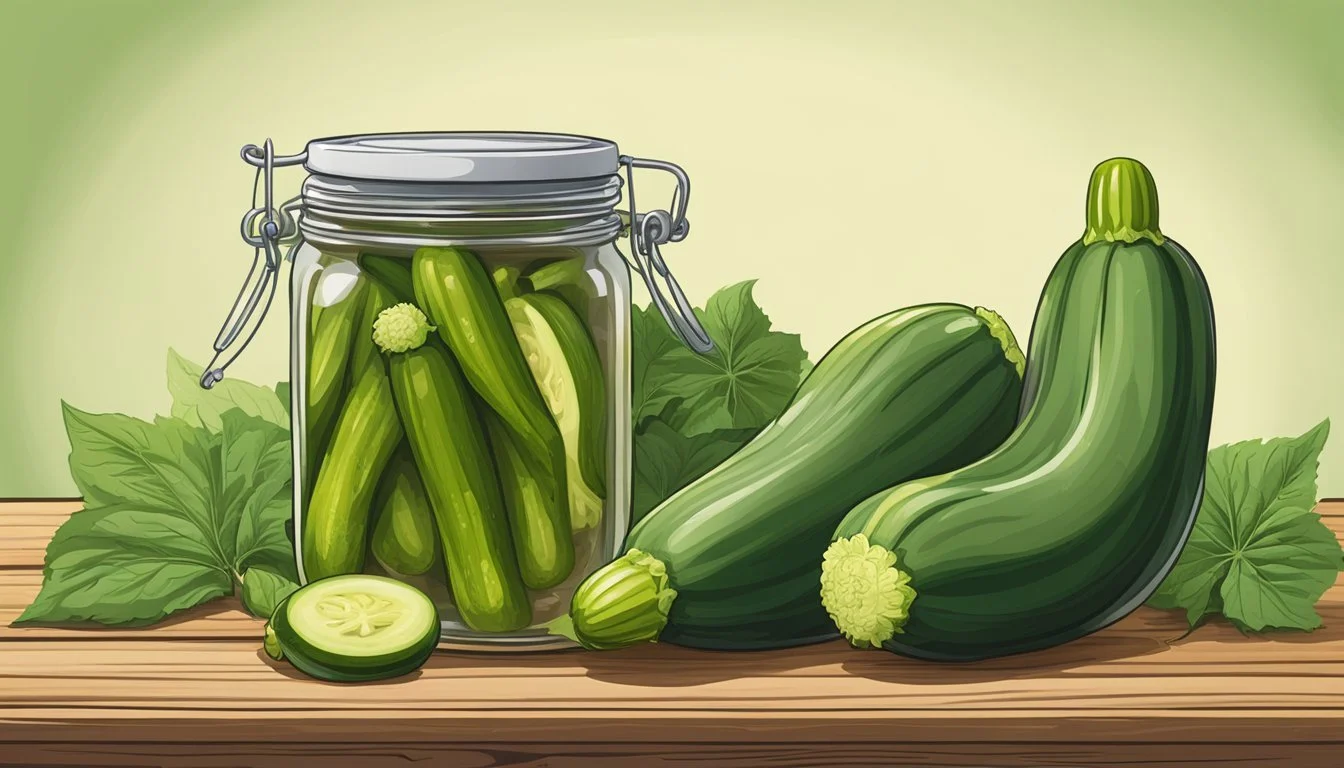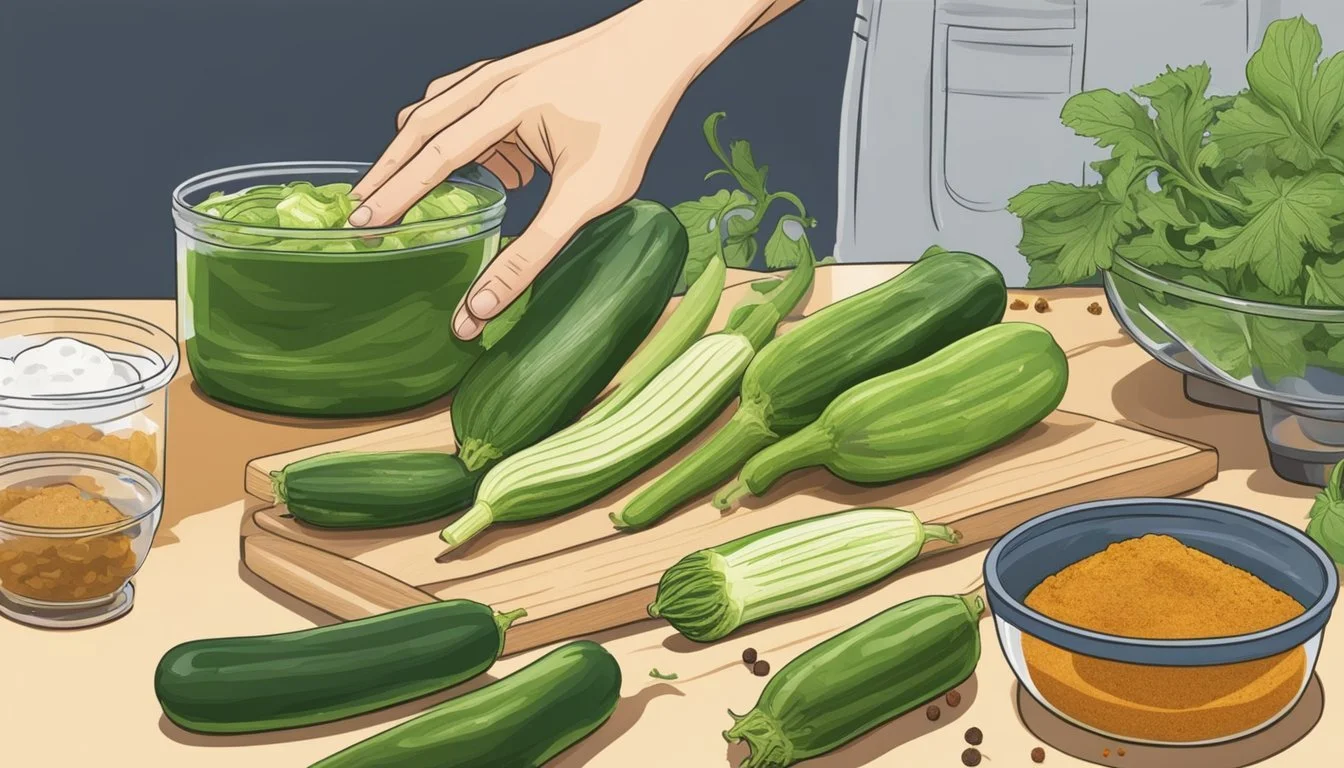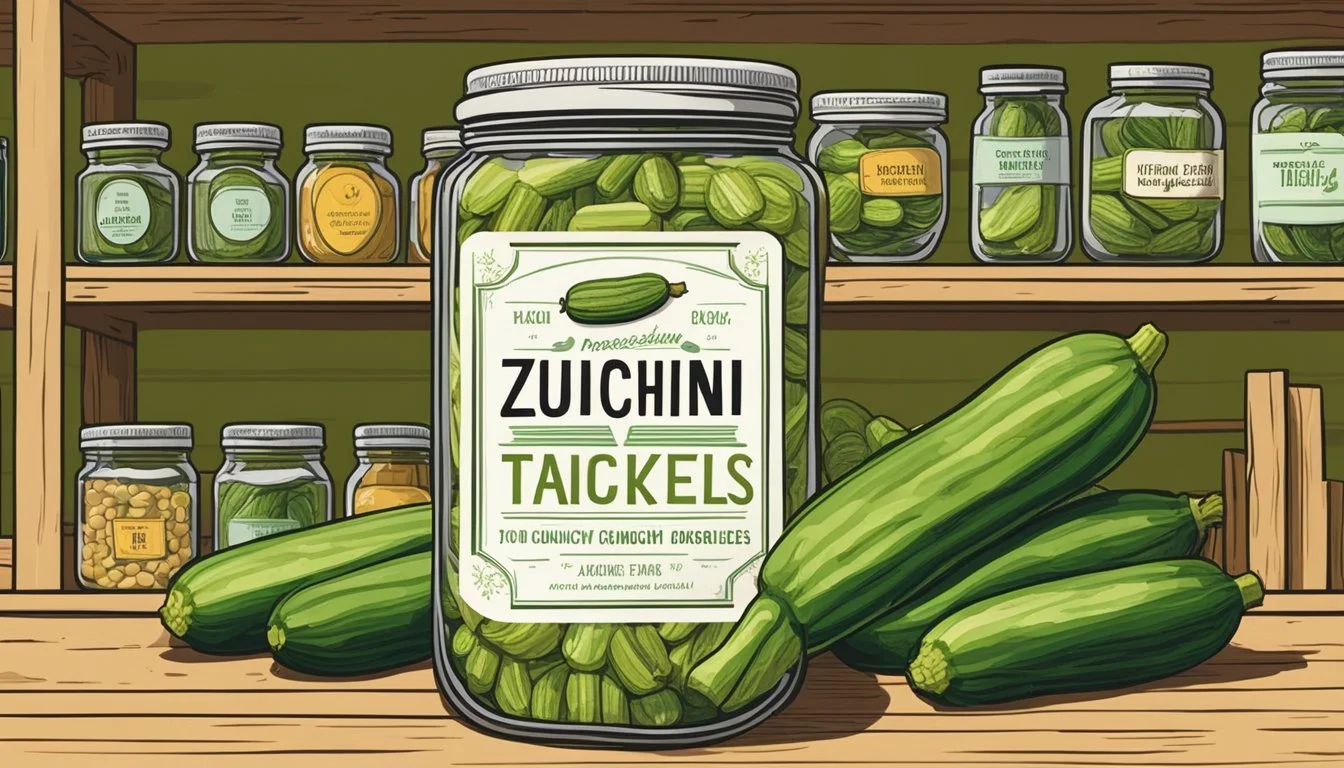Zucchini Stem Pickles
A Tangy, Crunchy Condiment for Gourmet Sandwiches
Zucchini (What wine goes well with zucchini?) stem pickles are a unique twist on the traditional pickling of vegetables, offering a tangy and crunchy condiment that is versatile in its use. These pickles capitalize on the firmer texture of zucchini stems, which often get discarded during food preparation. By pickling them, not only is food waste reduced, but it also creates an opportunity to enjoy a part of the vegetable that is frequently overlooked. The pickling process imparts a sharp and vibrant flavor to the stems, resulting in a condiment that can add a delightful zest to a variety of dishes.
The preparation of zucchini stem pickles involves a simple pickling brine, typically a mixture of vinegar, water, salt, and a selection of spices and herbs to infuse the stems with bold flavors. This brine can be adjusted to suit personal tastes, ranging from dill and garlic for a classic profile to more exotic spices for a unique twist. Once submerged in the brine, the zucchini stems undergo a transformation that enhances their natural crunchiness while soaking up the tangy essence of the pickling liquid.
With their tangy undertones and satisfying snap, zucchini stem pickles are rising in popularity among home cooks and artisanal producers alike. They serve as a delightful addition to cheese platters, sandwiches (What wine goes well with sandwiches?), salads, or as a stand-alone snack. The method also aligns with a larger movement towards sustainable and no-waste cooking, as it encourages the use of the entire vegetable.
Zucchini Pickles Origins and Overview
Zucchini pickles, known for their tangy and crunchy attributes, have a culinary footprint that spans multiple cuisines and continents. Although historically overshadowed by the ubiquitous cucumber pickle, zucchini, a summer squash, has found its way into the pickling tradition as a delightful alternative.
Origins
The practice of pickling vegetables stretches back thousands of years, with evidence pointing to ancient Mesopotamia. Zucchini itself is believed to have originated in the Americas, but it was not until the introduction of zucchini to Europe, where pickling was already a common practice, that zucchini pickles began to emerge.
Seasonality
Zucchini is a summer crop, flourishing in warm weather, which coincides with the traditional peak season for pickling. The timing allowed for the preservation of zucchini's freshness and nutritional benefits well beyond its natural growing season.
Nutritional Profile
Zucchini is nutrient-dense, boasting an array of vitamins and minerals in its composition. When pickled, it retains much of its nutritional value, including:
Vitamin A: Important for vision, the immune system, and reproduction.
Vitamin C: Helps with the growth and repair of body tissues.
Nutrient Benefit Vitamin A Supports vision and immune system Vitamin C Aids in growth and tissue repair
In their pickled form, zucchini maintains a balance of these essential nutrients, providing a healthful addition to meals.
As pickling has evolved, zucchini has become more prominent on the condiment shelves around the world, merging nutritional benefits with flavor. Accompanied by spices and vinegar, zucchini transforms into a versatile condiment enjoyed for its crunch and zest.
Selecting Ingredients
Selecting the right ingredients for Zucchini Stem Pickles is crucial to achieving a balance between tanginess and crunch. The selection of zucchini, spices, and vinegar directly influences the flavor and texture of the final product.
Best Zucchini for Pickling
For pickling, the ideal zucchini should be firm and fresh. Small to medium-sized zucchini are preferable as they have fewer seeds and tend to be more crisp. One should avoid overripe zucchini with soft spots, as they can become mushy during the pickling process.
Choosing Spices and Herbs
The typical spice mix for zucchini stem pickles includes:
Mustard seeds: a teaspoon for a subtle spice.
Peppercorns: around ten, providing a sharp counterpoint.
Dill: either fresh or dried, crucial for a classic pickle flavor.
Garlic: two cloves to infuse pungency.
One can experiment with additional spices like coriander or even add a tea bag for tannins, which can help retain crispness.
Vinegars and Their Impact on Flavor
Vinegar is a pivotal ingredient that dictates the tanginess of the pickles. For a balanced pickle:
Apple cider vinegar: offers a fruity undertone.
White distilled vinegar: gives a sharp, clean acidity.
Wine vinegar: can contribute a complex flavor profile.
Combining vinegars can create a unique taste, but it’s important to maintain a proper pH for preservation. For pickling liquid, a 1:1 ratio of vinegar to water is generally used, complemented with salt and sugar to enhance the flavor.
The Pickling Process
The art of pickling zucchini stems involves a combination of preliminary vegetable preparation, crafting a flavorful brine, and correctly jarring and sealing the condiment to ensure shelf stability and taste longevity.
Preliminary Preparation
Before one begins the pickling process, it is essential to ensure that the zucchini stems are prepared properly to absorb the brine. First, wash the stems thoroughly to remove any dirt or debris and then slice them into manageable pieces if needed. Next, one should dry the stems completely to avoid diluting the brine. Some recipes may require the vegetables to be salted and left to drain in the refrigerator, enhancing their texture and flavor absorption.
Creating the Brine
The brine is the flavorful liquid in which the zucchini stems will be pickled. To create the brine, one typically combines vinegar, water, sugar, and an assortment of spices and seasonings. Here's a basic recipe example:
Vinegar: 1 cup
Water: 1 cup
Sugar: 1 tablespoon
Salt: 2 tablespoons
Seasonings (such as mustard seed, dill, garlic): To taste
Combine these ingredients in a non-reactive pan and bring to a boil. Stir until the sugar and salt are completely dissolved. This transforms into the pickling agent that imparts the zucchini stems with a tangy flavor.
Jarring and Sealing
Once the brine is prepared and the zucchini stems are ready, they should be tightly packed into clean, sterilized jars. It is important that the jars have been sterilized to prevent any bacterial growth. After this, carefully pour the hot brine over the stems, ensuring to leave a small headspace at the top of the jar. Wipe the rim of the jars to remove any residue, which could impede sealing. Place a sterilized lid on each jar and secure it with a ring.
Finally, to seal the jars, they are processed in a hot water bath. This involves submerging the jars in boiling water for a set amount of time which varies depending on the recipe and jar size. After boiling, jars should be removed and set aside to cool. As they cool, the lids will seal onto the jars. One can verify a successful seal by checking if the lid has been sucked down and doesn't pop up when pressed.
Serving Suggestions and Pairings
Zucchini stem pickles add a tangy and crunchy element that complements various dishes and revitalizes everyday snacks. Their versatility in flavor profiles makes them an exceptional choice for a wide range of pairings.
Complementing Main Dishes
Zucchini stem pickles can transform a simple sandwich or burger into a gourmet experience. For sandwiches, they contribute a zesty crunch that balances creamy or rich ingredients, such as:
Roast beef sandwiches with a layer of zucchini stem pickles
Turkey and Swiss cheese paninis, enhanced by the tangy notes of pickle
Burgers benefit greatly from the inclusion of these pickles, offering an elevated taste with every bite. Consider:
Classic cheeseburgers paired with a generous topping of zucchini stem pickles
Vegetarian burgers where the pickles provide a flavorful contrast to earthy patties
Enhancing Snacks and Sides
Zucchini stem pickles can be more than just a topping; they serve as an excellent side or a key ingredient in relishes. Examples include:
A relish made from zucchini stem pickles, perfect for hot dogs or as a flavor boost for grain salads
Adding chopped pickles to potato or pasta salads for an unexpected twist
For a snack, zucchini stem pickles can be served alongside a variety of cheeses, creating an enticing platter that is both satisfying and light. Cheeses that pair well include:
Sharp cheddar, which balances the pickle's tartness
Creamy goat cheese, complemented by the pickles' acidity
Health and Nutrition
Zucchini stem pickles are not only a flavorful condiment to enhance meals, but they also offer a range of nutritional benefits. This section will explore the calories and macronutrients provided by zucchini pickles, as well as their content of essential vitamins and minerals.
Calories and Macronutrients
Zucchini stem pickles are a low-calorie option, ideal for those who are conscious about their calorie intake. Here is a breakdown of the typical macronutrient content in a one-cup serving:
Calories: Approximately 20
Carbohydrates: 4g
Protein: 1g
Fat: 0.2g
Saturated Fat: Negligible
Fiber: 1g
The pickling process does not significantly alter these macronutrients, keeping the zucchini stems light and diet-friendly.
Vitamins and Minerals Content
Zucchini is a good source of several vitamins and minerals which remain present even after pickling. Below is the content for a one-cup serving:
Potassium: 250-300mg
Calcium: Around 2% of the Daily Value (DV)
Iron: Approximately 4% of DV
Among the vitamins, Vitamin C is particularly notable, although it can be reduced during the pickling process due to its sensitivity to heat and light. Nonetheless, zucchini stem pickles still contribute to nutritional intake, especially when consumed as part of a balanced diet.
Storage and Shelf Life
Proper storage of zucchini stem pickles maximizes both their tangy flavor and crunchy texture. Adhering to specific refrigeration guidelines can significantly extend the shelf life of these homemade condiments.
Refrigeration Guidelines
After preparing zucchini stem pickles, it is crucial to ensure they are sealed in jars with tight-fitting lids. One should store these jars in the refrigerator, maintaining a consistent temperature to prevent spoilage. The following list outlines the necessary steps for refrigeration:
Seal: Tightly seal the jar with a lid to avoid contamination.
Stabilize: Keep the refrigerator temperature stable, ideally between 35°F-38°F (1.7°C-3.3°C).
Isolate: Store pickles away from strongly-odored foods to maintain their flavor integrity.
Check: Regularly inspect the seal and the pickles for signs of spoilage such as off-odors or colors.
Shelf Life Expectancy
Zucchini stem pickles have varying shelf lives depending on the pickling method used. When stored correctly in the refrigerator, the expected shelf life details are as follows:
Room Temperature: Not recommended for long-term storage. Consume within a few hours.
Fridge: Typically lasts for 2-3 months when kept in the refrigerator.
By following these guidelines, one can enjoy the unique taste and crunch of zucchini stem pickles for an extended period.
Recipe Variations and Customizations
When crafting zucchini stem pickles, the unique tangy and crunchy profile can be enhanced by adjusting spice levels and experimenting with different vinegars. These customizations allow one to tailor the condiments to their taste preferences or to complement specific dishes.
Adjusting Spice Levels
To modify the heat intensity, mustard seeds and red pepper flakes are key ingredients. The baseline recipe may call for a teaspoon of yellow mustard seeds, providing a milder heat. For those seeking a more piquant experience, increasing yellow mustard seeds to a tablespoon or adding a teaspoon of red pepper flakes can significantly elevate the spice. Conversely, reducing the mustard seed portion will yield a subtler flavor.
Experimenting with Different Vinegars
The choice of vinegar directly impacts the acidity and flavor of the pickles. White vinegar, with its sharp and clean taste, is a common choice. However, one can opt for apple cider vinegar for a hint of fruitiness and additional depth of flavor. Distilled white vinegar stands as a neutral choice that carries other flavors well, such as turmeric, which can also add a vibrant color to the pickles. Each type of vinegar may affect the overall taste profile, hence experimentation can lead to discovering the perfect match for one's palate.
Canning and Preservation Techniques
Preserving zucchini stem pickles involves canning techniques that ensure safety and flavor retention. Two popular methods are water bath canning for long-term storage and preparing refrigerator pickles for immediate consumption.
Water Bath Canning
Water bath canning is a process suitable for high-acid foods, including pickles made from zucchini stems. Individuals can use mason jars to seal their pickles effectively. Here's a brief overview of the steps:
Sterilize mason jars and lids in boiling water.
Prepare the zucchini stem pickle mixture according to a tested recipe, ensuring it contains sufficient acidity.
Fill the jars with the hot pickle mixture, leaving a 1/2-inch headspace.
Remove air bubbles by gently stirring the contents.
Wipe the rims clean, place the lids on the jars, and secure with the rings.
Process the jars in boiling water for the time specified by the recipe, with water covering the jars by at least 1 inch.
Allow jars to cool undisturbed for 12-24 hours and check for seals before storage.
Refrigerator Pickles
For those not interested in long-term canning, refrigerator pickles offer a quicker alternative. These are not intended for shelf storage and should be consumed within a few weeks. The process is straightforward:
Slice zucchini stems and prepare the pickling brine with vinegar, water, and chosen seasonings.
Place the zucchini stems in a clean jar, pour the brine over the top, and ensure the stems are completely submerged.
Seal the jar and store it in the refrigerator for at least 24 hours before enjoying, allowing the flavors to meld.
This method does not require a water bath and is ideal for preserving the crunch and freshness of the zucchini stem pickles.








